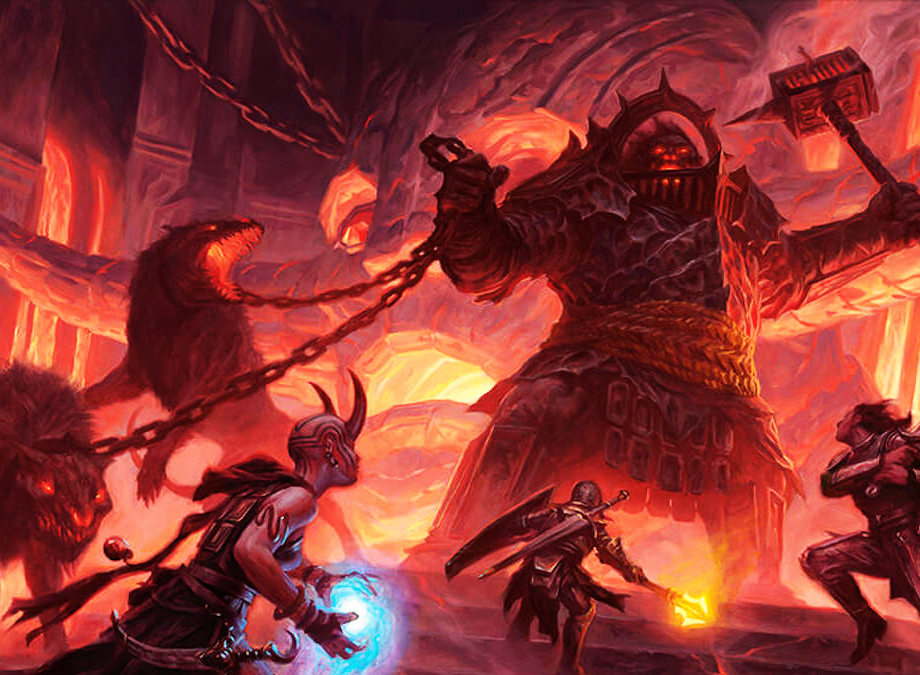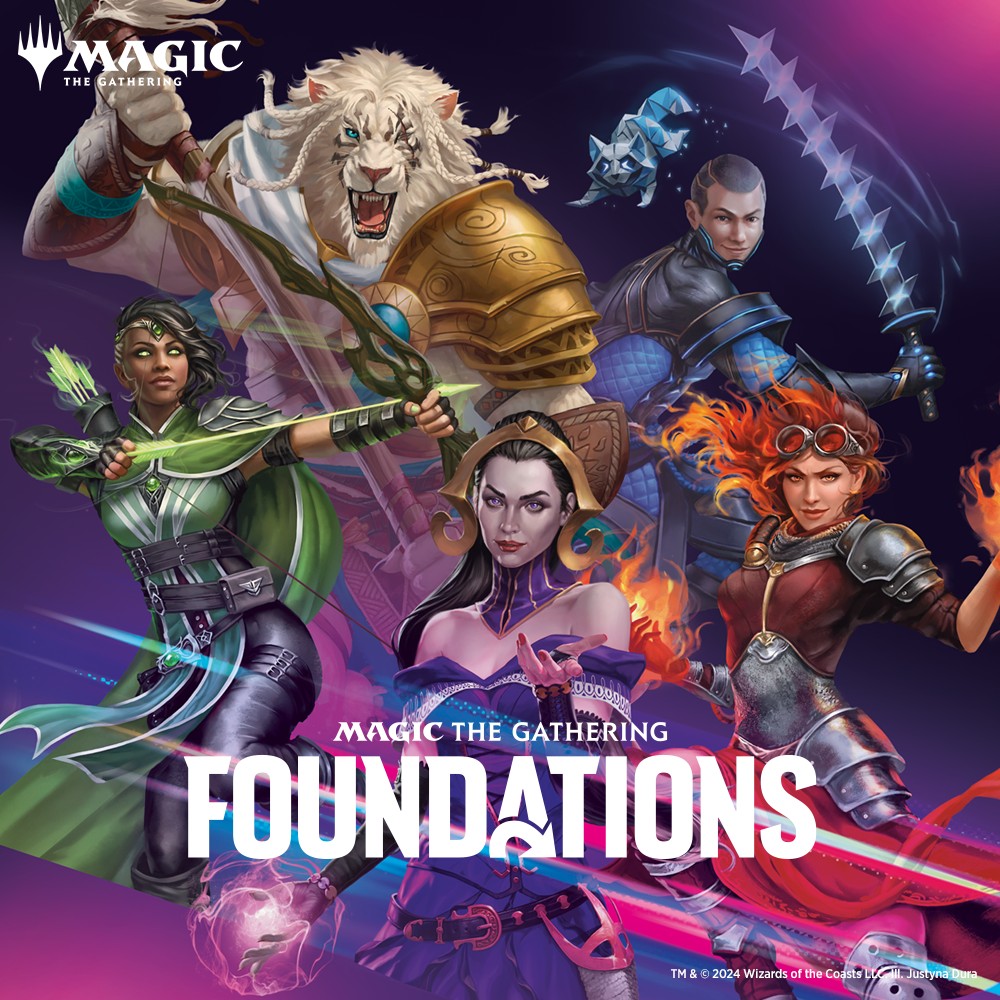Finding Balance
Published adventures and encounters in D&D are often given a range of appropriate levels for the characters who attempt it. To some degree, the CR system for individual monsters can be interpreted as a recommended range as well. These should be looked at as guidelines, and will almost certainly need additional 'tweaking' to fit your party. But how? What should I adjust? How do I know if it's too strong or not strong enough?!? The answers to these questions and more await you below as we discuss how to balance a D&D encounter!
An Example
Let's say we pick up a new adventure called "Toll of the Death King's Reaping" (I 100% just made that up, but it sounds awesome and I want to play it now...) and it says "An adventure suitable for players between 5th and 8th level". What does that actually mean? Essentially, it is a guideline to help you know a) if this will fit into your current, ongoing campaign, or b) what level of character you should tell the players to create if you are playing it as a one-shot or stand-alone adventure. Regardless of how you are going to approach playing this new (awesome-sounding!!) campaign of yours, you, as the DM, are likely going to need to adjust some things to make this work. It needs to bed be fun and challenging but not so challenging that everyone dies right away.
Let's say that our party is at level 5 as they set out to put a stop to this Death King's shenanigans; this will probably be a challenge for them. Compare that to another party at level 8, who might just walk up to the Dreaded Castle Mort, kick open the door and send that King back to the negative planes where he belongs without breaking a sweat (it probably wouldn't be that easy, but you get my point). Armed with the range of acceptable player character levels as our guide, we can start the somewhat daunting process of balancing it for our party, meaning, making sure everyone can have fun while playing it.
There are many factors to consider other than just their level and, sadly, there is no "right way" to do this. What I'm going to focus on here is how to find out what 'balanced' means for your group, some tips on what to adjust and by how much, and finally a few red flags to watch out for.
What 'Balanced' Means
This word takes on a different meaning for every single group that plays a given adventure, but there are a few categories that we can start looking at. In general, you want to look at 3 things:
- The type of game your players and you are looking for
- The type of players you have, and their experience level
- The current capabilities of the group
Let's break it down.
Type of Game
Some people like to play a very challenging, low magic, gritty, and serious game. Others like to play high magic, high power, but still a serious game. Still others just like hanging out with their friends and telling some cool stories together while eating pizza. All of these are 100% valid ways to play D&D and the type of game you want to play is going to play a large part in how you balance it. If your level 5 party is going for that serious, grimdark feeling, you may want to increase the challenges presented in this adventure a little, or maybe a lot. If they're really just there for the Cheetos (which, again, is totally fine), maybe you need to dial it back a bit. Knowing what vibe you are going for will give you the broad strokes on finding what balance means for your group.
Type of Players
This goes along with the first point a little, but you need to consider what experience level your players have. If they are relatively new or are not really interested in optimizing their characters for maximum damage output, this is a sign that you might need to water down some of the encounters. Conversely, if you are a group who loves building the most efficient characters possible, dial it up a bit and optimize the monsters as well.
Current Capabilities
If your level 4 group is loaded down with +3 Flame Tongue Longswords of Ultimate Banishment, Tattoos of Supreme Invulnerability, and Scrolls of Tarrasque Summoning (that's a real thing now!!) they are going to waltz through this adventure, even though they are only at level 4. Knowing the average amount of damage your party can typically do each encounter or each round is going to be a good indicator of how strong they are. Not all level 5 parties are made the same way! You should also take into account the makeup of the group. A party with 2 or more healers is a very different party than a party with no healers at all. Also, some character builds can have consistently massive damage capabilities (I'm looking at you Rogues and Paladins...) and if your party has several of these massive damage dealers, you need to account for that if you want to keep it challenging for everyone.
Balance Analysis
Now that we have defined what type of challenge level we are looking for, we can measure that against the guideline given to us. For our example, let's say we have a level 6 party with several magic items (let's say 1 each) and they are looking for a serious, challenging game. They are moderately experienced and they have built their characters to be mostly optimized. Based on this, we probably need to increase the difficulty a little bit to keep it challenging for everyone. This part here is probably the most important step, and as awesome as it would be to have a spreadsheet calculate all of this for us, there really isn't a set formula to tell us the answer here. This is a very 'gut feeling' type of analysis that, while based on levels and damage outputs and proficiency bonuses, can't really be 100% accurately reduced to an equation. While I'll show you some math down below, it's really only a vague indicator that will ultimately get trampled on by the dice and your player's decisions. There are lots of spreadsheets and calculators out there (Expected Damage Per Round, Chance to hit ratio etc.) but they are all fairly complicated, potentially overwhelming, and, in my opinion, overkill. If math is your thing and you love to get into detailed statistics that's great, but it is not necessary to go into that much detail. You can absolutely balance a D&D encounter without a master's degree in statistics. This is an exercise that you will get better at over time and the only way to learn it is by doing it (and occasionally messing it up... RIP Tobrune). So don't be afraid to try some stuff out, and be very ready to improvise your way out of the situation that you've made for yourself!
To the Levers!
Now that we know the direction we need to adjust this thing, there are a few things that we can do to increase or decrease the challenge of Good ol' King Death and the Toll of his Reaping. We'll start with the more broad changes and move our way down into the details.
Number of encounters
One of the most efficient ways to alter the challenge level of an overall adventure is to play with the players' resources. If they are blasting through encounters with ease, add in some lower-level 'gatekeepers' or random encounters (travel or environmental ones are great). Social encounters can be resource drains as well, if you have magic users that expend spell slots to get past them (charm person, disguise self, etc.). Finally, you can think about creating some traps that are specifically designed to drain their resources. This could be spell slots, hit points, hit die, or effects that cause exhaustion or impose disadvantage for certain things.
Number of short and long rests
This is essentially doing the same thing as above, but limiting the amount of rest they get and how often they get it is a simple way to constrain their resources. It helps to maintain realism if there is a reason why they can't rest, so try to have something that makes sense here. Maybe King Death's minion zombies are harassing them throughout the night and their rest is interrupted, or maybe they need to make Wisdom Saving Throws and on a failed save they are haunted by terrifying nightmares and only regain half of their lost HP. Whatever the reason, keeping them from being at 100% health and spell slots at the beginning of an encounter will absolutely increase the challenge and tension of the game.
Number of enemies
You can adjust the number of enemies in an encounter fairly easily, but the trick is to know by how many. You can steal a really great mechanic from 4th edition and introduce 'minions' to make an encounter more difficult, but without adding too much complexity. Essentially, a minion is a regular monster but it only has 1 hit point. If anyone hits one, it dies. This gives a little boost to the action economy of the enemy side but simplifies the DM's life considerably. These should be lower level than the main enemy, but don't limit yourself to only goblins and kobolds. Feel free to try out some cool, mid-level monsters if it makes sense and, if necessary, reduce their attacks as well.
To make an encounter less difficult, reducing the number of monsters isn't always an option (like if there is only one to start with...) so that is where we will need to look at some other options for adjusting an individual monster's abilities.
Hit Points
This one is probably the most straight forward. You want your monster to last at least 3 rounds to feel moderately challenging. More rounds if you want it to be even more of a challenge and fewer rounds to make it a bit easier, but 3 is generally a good target. To do this, first look at the average damage that your party can deal. Take the strongest attack for each character and take the average damage value (4d8+4 give you average damage of 20 [ (4 x 8 / 2) + 4] ), add everyone's number together, and then multiply it by 75%, because not all attacks will hit. This is your average total damage dealt per round. For our party, let's say we get 89 * 75% which gives us 66 (rounding down). We are going to want our monster to have - at a minimum - 198 (3 x 66) hit points to last the three rounds. If we want to make this more challenging now, we can simply add HP, or if you're comfortable with it, add in some resistances and immunities. If you make a creature resistant to all damage (don't do that, it's just an example...) you are essentially doubling its HP so you can use that as a guideline. Effects that allow the monster to regain HP can be interesting too, why can't they cast healing spells like the good guys?
Armour Class
Increasing the monster's AC reduces the chance that it will get hit, effectively reducing the average total damage dealt per round. Take your average damage dealt, 89 for our party, and reduce the percentage a bit. You can get into the detailed statistical analysis of the players' to-hit bonuses vs the AC etc. but for our purposes let's keep it simple. Each additional point of AC will reduce the chance to hit by approximately 5%. So if we increase AC by 1, instead of 75%, use 70%. In our example, this gives us 46 for our average total damage dealt per round. That's a pretty big difference! Keep this in mind, however: The less often your players hit the monster, the less fun it is for them. Keeping AC low and HP high, in general, will result in more satisfying combats. You want to stay in the middle somewhere though, impenetrable AC sucks, but so does never-ending slog fest. You can give your NPC villains a reaction to temporarily increase their HP, like the parry ability to make things interesting here, but don't limit yourself to only that.
Spells or Special Actions
Giving your monster a few extra spells or abilities might be enough to give the encounter the edge you're looking for. If the HP and AC are close to being where you want them, but you want to give it just a little bit of spice, an area of effect spell or something that imposes a condition on a player can probably be enough to make it interesting.
Damage
Finally, you can adjust the amount of damage that the creature can do. This is essentially the reverse of the calculation that we've already done for the party, but you want to make sure you lookout for a few red flags. Damage that is over twice a character's total HP will outright kill them, which sucks for the player and should be reserved only for the nastiest of monsters. Look at your party average HP and take note of the lowest and highest values. Look at the monster's strongest attack. This number should be very close to the lowest party member's Maximum HP. In our example let's say we have a wee halfling that has a max HP value of 51. Our monster shouldn't have an average damage output higher than 51 unless we want the real possibility of killing wee Tompkins outright. If you want to really increase that threat level though, damage that takes a player to 0 HP in one hit is pretty' scary.
There is a really great, often overlooked table on page 249 in the Dungeon Master's Guide that gives a guideline on how much damage severity by level called Damage Severity and Level. It gives you a very broad idea if your damage is a setback, dangerous or deadly amount, broken down by each tier of play. It gives the amounts in xd10, but there are a few other resources online (Damage Dice Calculator and a nice discussion on Reddit here) that break it down to the other dice values. This is super handy when you are creating some homebrew monsters (spoiler alert! upcoming article!) so keep this one handy.
A Fine Balance
Balancing encounters and adventures in D&D is hard, there's no way around it. The number of variables to contend with makes it a truly challenging task that is more art than science. But if you keep the goal of having fun at the forefront of your mind (and what fun means for your players!), you are sure to succeed! Practice, experiment and improvise and you will find the balance you have been searching for.
That's all for this week, and don't forget there are 20 sides to every story!
-The Intrepid Adventurer


